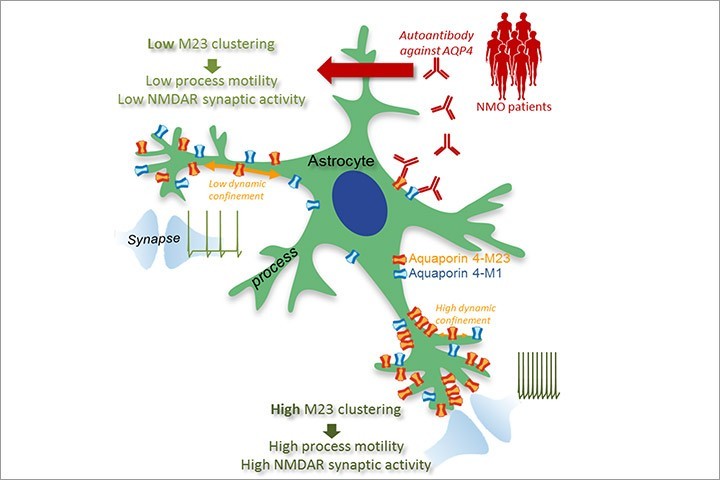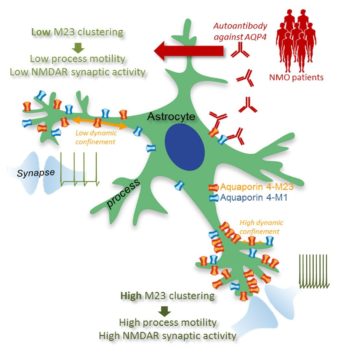
Laurent Groc, Thomas Tourdias et al in Cell Reports
Aquaporin-4 Surface Trafficking RegulatesAstrocytic Process Motility and Synaptic Activity inHealth and Autoimmune Disease
https://doi.org/10.1016/j.celrep.2019.05.097
Silvia Ciappelloni (1,2,3), Delphine Bouchet (1,2), Nadège Dubourdieu (2,3), Eric Boué-Grabot (2,4), Blanka Kellermayer (1,2), Constance Manso (1,2), Romain Marignier (5), Stéphane H. R. Oliet (2,3), Thomas Tourdias (2,3)* and Laurent Groc (1,2)*
1 Interdisciplinary Institute for NeuroSciences, CNRS UMR 5297, 33077 Bordeaux, France
2 Université de Bordeaux, 33077 Bordeaux, France
3 INSERM U1215, Neurocentre Magendie 33077 Bordeaux, France
4 CNRS, Institut des Maladies Neurodégénératives, UMR 5293, 33000 Bordeaux, France
5 INSERM U1028, CNRS UMR 5292, Center for Research in Neuroscience of Lyon, Lyon, France
*These authors share seniority
Correspondence should be addressed to
Abstract
 Based on the long-standing collaboration between Groc’s and Oliet’s labs, Silvia Ciappelloni and collaborators use an array of fluorescent imaging approaches to investigate how astrocytes control the dynamics of their highly-ramified processes. Indeed, astrocytes constantly adapt their ramified morphology in order to support brain cell assemblies. Such plasticity is partly mediated by ion and water fluxes, which rely on the water channel aquaporin-4 (AQP4). The mechanism by which this channel locally contributes to process dynamics was quite elusive. Here, we investigated in hippocampal astrocytes the dynamic distribution of the AQP4 isoforms, i.e. M1 and M23. Surface AQP4-M1 formed small aggregates that contrast with the large AQP4-M23 clusters that are enriched near glutamatergic synapses. Strikingly, stabilizing surface AQP4-M23 tuned the motility of astrocyte processes and favors glutamate synapse activity. Furthermore, human autoantibodies directed against AQP4 from neuromyelitis optica patients impaired AQP4-M23 dynamic distribution and, consequently, astrocyte process and synaptic activity. Collectively, we thus propose that the membrane dynamics of AQP4 isoform regulate brain cell assemblies in health and autoimmune brain disease targeting AQP4.
Based on the long-standing collaboration between Groc’s and Oliet’s labs, Silvia Ciappelloni and collaborators use an array of fluorescent imaging approaches to investigate how astrocytes control the dynamics of their highly-ramified processes. Indeed, astrocytes constantly adapt their ramified morphology in order to support brain cell assemblies. Such plasticity is partly mediated by ion and water fluxes, which rely on the water channel aquaporin-4 (AQP4). The mechanism by which this channel locally contributes to process dynamics was quite elusive. Here, we investigated in hippocampal astrocytes the dynamic distribution of the AQP4 isoforms, i.e. M1 and M23. Surface AQP4-M1 formed small aggregates that contrast with the large AQP4-M23 clusters that are enriched near glutamatergic synapses. Strikingly, stabilizing surface AQP4-M23 tuned the motility of astrocyte processes and favors glutamate synapse activity. Furthermore, human autoantibodies directed against AQP4 from neuromyelitis optica patients impaired AQP4-M23 dynamic distribution and, consequently, astrocyte process and synaptic activity. Collectively, we thus propose that the membrane dynamics of AQP4 isoform regulate brain cell assemblies in health and autoimmune brain disease targeting AQP4.
Last update 08/07/19
